Survivor Anita Lasker lives on.
Matt A Hanson
Matt A Hanson (he/him/his) is an art writer and freelance journalist of Romaniote descent based in Istanbul. His latest essays on Sephardic literature are forthcoming with Tablet Magazine and The Jewish Review of Books.
Violinist Alma Rosé, the niece of famed Austrian composer Gustav Mahler, had an unfortunate reputation as a “kapo,” or trusted inmate of the Nazis. She conducted the Women’s Orchestra of Auschwitz — but she bemoaned the lack of a cellist. When one finally arrived, number 69388, their meeting in the barracks promised salvation in return for a seat under Rosé’s iron baton.
That cellist was Anita Lasker, the Women’s Orchestra of Auschwitz’s only remaining survivor. She auditioned for Rosé by playing Franz Schubert’s “Marche militaire” like the professional musician she was raised to be. For years prior, under Nazi rule, teachers from her native Breslau to Berlin refused to accept her, a Jewish student. In 1942, she dropped the cello to work in a paper factory with her sister while her parents were likely massacred digging their own graves in Lublin. Without music lessons, and with nothing to lose, she secretly aided the French resistance. She was arrested while escaping to France.
In December of 1943, she entered Auschwitz, soon playing for new arrivals while 12,000 people were gassed each day. After committing crimes of genocide, SS officers found respite in Lasker’s cello. She performed Schumann’s “Traümerei”for Josef Mengele, infamous as the “angel of death” for his deadly medical experiments — and she overheard him saying he was touched by her talent.
Rosé perished in Auschwitz from what historians agree was food poisoning. Her 40-strong Women’s Orchestra banded together, even after the Red Army evacuated them in October of 1944. Lasker was reunited with her sister Renate, but the two fared a harsher reality in Bergen-Belsen, attempting suicide by swallowing cyanide only to discover it had been replaced with sugar. That spring, the British freed them. A senior officer gifted Lasker a cello. She sent for étude books and attended concerts that Benjamin Britten and Yehudi Menuhim gave for lingering survivors.
The Deutsche-Welle documentary “The maestro and cellist of Auschwitz” includes footage of Lasker walking with Renate through the gates of Bergen-Belsen. They have full heads of hair and smile, appearing healthy despite surviving detention for three years beside growing heaps of corpses. When a BBC crew arrived, Lasker began her lifelong act of testimony before microphones — not as a cellist, but a witness. The UK’s Holocaust Memorial Day Trust published a summary of her book, “Inherit the Truth”, in which she described what it felt like at about 5pm on April 15, 1945, when she realized she’d survived.
After an interlude in Brussels, during which time she found a cello teacher and joined the university’s symphony orchestra, she moved to England, where she married Peter Wallfisch, another Jewish musician from her hometown (now the Polish city of Wrocław). She went on to found such institutions as the English Chamber Orchestra, where her cello resounded. At 97, she is quieter on the concert stage, but remains outspoken in interviews and speeches — whether railing against antisemitism in front of the German Bundestag in 2018 or detailing her traumas with cold perspicacity in her thick German accent.
Lasker was born in 1925, a year after my grandmother, whose name, Anita, is not their only coincidence: Both were also classical musicians. As the daughter of the multilingual Katz family from what is now Ternopil, Ukraine, my mother’s mother studied to become a concert pianist, accompanying the violins of her father and brother while her mother, Amelia, wrote letters in Yiddish to relatives (including those of cellist Steven Isserlis) — all of whom perished in the Holocaust. Like the Lasker family, the Katzes’ love of music and science assimilated them into the European cultures that they proudly upheld, even while they suffering from their persecution.
The details of Lasker’s life are the subject of the only chapter dedicated to a Jewish woman in Flemish radio host Fred Brouwers’ book “Beethoven in the Bunker: Musicians Under the Nazi Regime.” Brouwers presents a broad selection of figures and examines how adoration by Nazis sometimes exempted Jewish musicians from an early grave. Lasker is a clear example of how music can sometimes save lives. In Hitler’s final hours, he listened to Jewish musicians Arthur Schnabel, Felix Mendelssohn, Jacques Offenbach and Bronisław Huberman.
One of Lasker’s widest-circulating performances is on the 2006 album of compositions by her son, Benjamin Wallfisch. She plays cello for the piece, “Requiem”, along with her other two sons, Raphael and Simon. Its tense, modernist aura evokes unresolved, multigenerational trauma.
Lasker’s life inspired a flawed film in 1980, “Playing for Time.” It was written for television by Arthur Miller from Fania Fenelon’s 1976 memoir, “Sursis pour l’orchestre” (translated into English as “The Musicians of Auschwitz” in 1977), and was initially a play — Miller’s least-produced and most-contested. In the movie, Lasker is not represented as a title character. Instead, she is simply known as “the cellist,” a moniker that she has repeatedly stated saved her from execution. In one scene in the movie she is rushed to the infirmary due to malnourishment, and Rosé begs the guards not to kill her sole cellist.
In 2016, the publication of “The Truth about Fania Fénelon and the Women’s Orchestra of Auschwitz-Birkenau” by music historian Susan Eischeid revealed the yawning gaps in the truth behind Fenelon’s memoir, critiquing its status as a cornerstone of Holocaust remembrance. Lasker contributed to Eischeid’s research along with a fellow member of the Women’s Orchestra of Auschwitz, Helena Dunicz Niwińska, who passed away in 2018 in Poland.
After their correspondence in 2014, Eischeid quoted Lasker, who said that Fenelon’s book was “completely misleading.” Lasker is still alive, telling it like it was, playing in real time.




